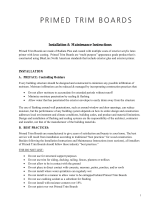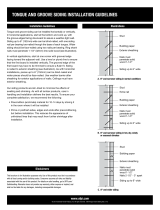10
a more rigid film that can crack or
blister if the wood moves exces-
sively as a result of changes in
humidity.
Acrylic latex paints are more flexi-
ble and will consequently shrink
and expand with the wood, making
them less prone to cracking.
The recommended application for
most species is one brush coat of
acrylic latex primer followed by two
coats of 100% acrylic latex paint.
For species high in extractives
such as Cedar, use an oil-based
primer or stain-blocking latex
primer, then two coats of acrylic
latex paint.
To enhance the performance of a
paint finish, prefinish the siding with
one coat (or dip) of a paint-compat-
ible water-repellent preservative
prior to priming and painting. This
can increase the life of the finish by
up to 10 years.
Finishes to Avoid
Do not use varnishes, lacquers or
other clear, film-forming finishes on
exposed wood. These finishes
become brittle, allow UV degrada-
tion, can crack and peel, and are
difficult to remove. Also avoid pure
linseed oil or linseed oil/turpentine
mixtures. Such finishes attract dirt
and are prone to mildew.
Application Methods
The best method for applying
most finishes is with a brush (water
repellents may be dipped).
Brushing usually puts more finish
on the wood surface, extending its
service life. On rough-sawn siding,
a brush serves to work the finish
around the rough wood fibers.
All siding surfaces (face, edges,
ends and back side) should have a
coat of protection before
installation.
When all surfaces are coated,
moisture movement in and out of
the siding is equalized and the
potential for cupping and splitting is
minimized.
Prefinishing also minimizes unfin-
ished lines that can occur at joints
and laps if the siding shrinks during
exceptionally dry summers.
may last up to five years.
Semitransparent stains do not last
as long on smooth sidings.
Opaque (solid or heavy-body)
stains, have more pigment than
semitransparent stains. Think of
them as thin paints. Wood grain
and color are not visible through
opaque stains, but surface texture
(roughness) is.
Opaque stains are available in oil-
or water-based formulations; how-
ever, oil-based formulations are rec-
ommended for cedar siding.
Opaque stains may form a thin film
on the wood surface and some can
be subject to flaking. Opaque stains
are not recommended over smooth
siding unless a compatible primer is
used prior to staining.
Service life is typically three to
seven years, depending on the sur-
face texture, exposure of the build-
ing and number of previous appli-
cations.
Primers and Paint
A paint system, properly applied,
will provide more protection and
last longer than other finishes.
Paints are film-forming finishes that
resist moisture absorption and
block ultraviolet rays. The variety of
colors makes paint a popular finish;
lighter colors are recommended
over darker colors.
If good performance is to be
expected, primers must be used.
Primers are generally oil or water-
based. Acrylic latex (water-based)
primers are recommended for most
wood species.
However, for woods naturally
high in extractive content, such as
Western Red Cedar, stain-blocking
(oil-based or latex) primers must be
used to help minimize discol-
orations that can occur when water
interacts with the natural extrac-
tives, causing them to bleed
through the surface of the primer.
The primer must prevent the natur-
al extractives in the wood from
interacting with the water in subse-
quent finish coats.
Paints are formulated using either
an oil (or alkyd) base or water base.
Oil-based paints are generally
more effective at blocking moisture
than are acrylic latex paints. How-
ever, oil-based paints tend to form
months. They are typically used on
cedar siding.
Because of the pigmentation
included in the formulation, bleach-
ing oils and stains will color the
wood grey upon application. Then,
as the siding is exposed to sun and
water, the bleaching oils begin to
bleach the wood itself, resulting in a
more uniform weathered look than
can be achieved naturally.
Bleaching oils bring about a
silvery-grey appearance that can
last for many years. However, the
protection offered by the oils may
only last two or three years.
Consequently, it is a good idea to
periodically apply a clear water
repellent to the siding, over the
bleaching oil, to protect it but not
alter the color. If siding color
becomes uneven over time, simply
reapply another coat of bleaching
oil.
Stains
Stains are pigmented finishes that
provide color and protection
against ultraviolet rays. Many are
also water repellents and may
include mildewcides and
preservatives as well.
When selecting a stain, make
sure it is a water-repellent stain that
contains at least a mildewcide.
Stains are recommended
for use on rough or saw-textured
siding.
Stains are classified as semitrans-
parent and opaque.
Semitransparent stains have a
moderate amount of pigment, pro-
vide a fairly uniform color without
hiding the wood grain. Oil-based,
semi-transparent stains are recom-
mended as they penetrate the
wood surface more than water-
based products.
As semitransparent stains do not
form a film, they are not subject to
peeling or blistering but do wear off
gradually.
Semitransparent stains can be
expected to last from two to five
years, depending on the surface
texture of the wood, the exposure
conditions and the number of previ-
ous applications. For first-time
applications on saw-textured siding,
semitransparent stains may last two
years. Subsequent applications



















